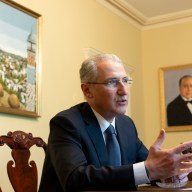It’s not every day that college undergrads get the chance to change the world.
At Seneca College’s School of Computer Studies, however, students are given the opportunity to do just that, while working in unison with industry leaders writing software programs used across continents. It’s quite a unique experience, providing students the chance to make some serious headway in their field before even earning a diploma.
Evan Weaver, chair of school, explains how students interested in open source software development are able to take part in an exclusive program that is quite rare for undergrads at other institutions. In fact, Seneca is even working to bring the success of their program to other universities across North America and around the world.
“Where we’re leading the world is where we involve our undergraduate students in these top-level, world-class open source projects,” Weaver told Metro.
For those who may be unfamiliar with open source software, it refers to the public release of code used to produce various software. Therefore, people can make modifications to the software to improve it or make it specific to their needs. Popular examples of this type of software are Mozilla’s Firefox Internet browser and the Linux operating system.
According to Weaver, the concept and popularity of open source programming is reaching critical mass and is set to blow. And Seneca’s program is the blueprint to take it to the next level.
“If you’re a software developer, it’s a really phenomenal opportunity,” he said.
If you ask Seneca grad and current Mozilla employee Armen Zambrano-Gasparnian, it’s quite the career. He says it’s challenging, engaging and gives him the opportunity to do some really interesting stuff.
“I took projects I didn’t know how to write,” he says, “but I was able to apply skills I learned in the program to get me through it. It’s allowed me to stop being fearful and take on any challenge. It gave me great confidence.”
Zambrano-Gasparian has been working full-time with Mozilla since May as a release engineer. He’s part of a nine-person team working on turning code written by programmers into serviceable products.
Basically, he says they handle the “architecture of the product.” He also says he had no idea a job like this existed before he got hired.
He got his start with Mozilla as a student at Seneca when he took advantage of their open source courses and learned he could work directly with Mozilla (through school). This turned into an internship, contract work and then finally, full-time employment.
Mozilla currently has 30 interns on hand from all over North America. Five of the 30 are from Seneca, while others come from such noteworthy universities as MIT, Stanford, Carnegie-Mellon and Waterloo.
Over the past two years, Seneca has had substantial representation at Mozilla. 2009 has seen five interns and three full-time hires — a true testament to their leadership in the field.
For more information on how to become enrolled in Seneca’s School of Computer Studies (at York), visit cs.senecac.on.ca/.














